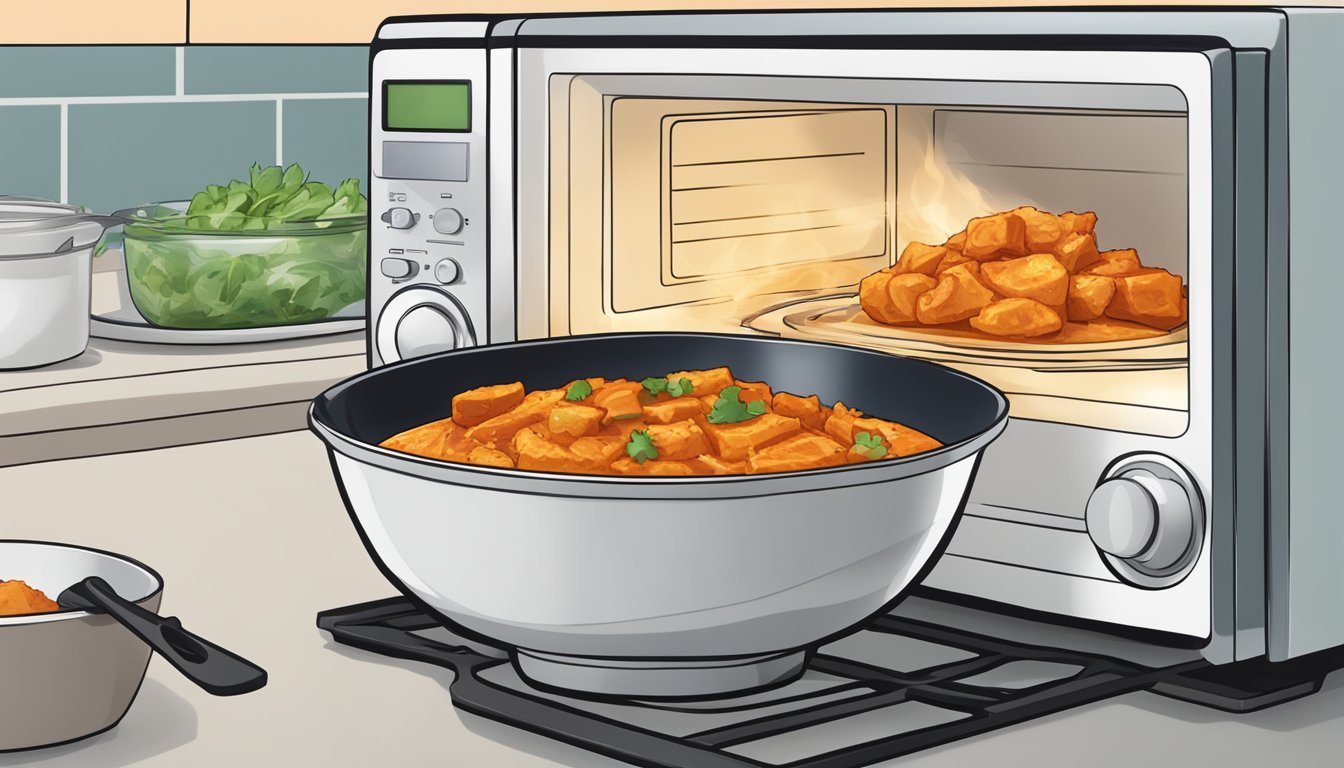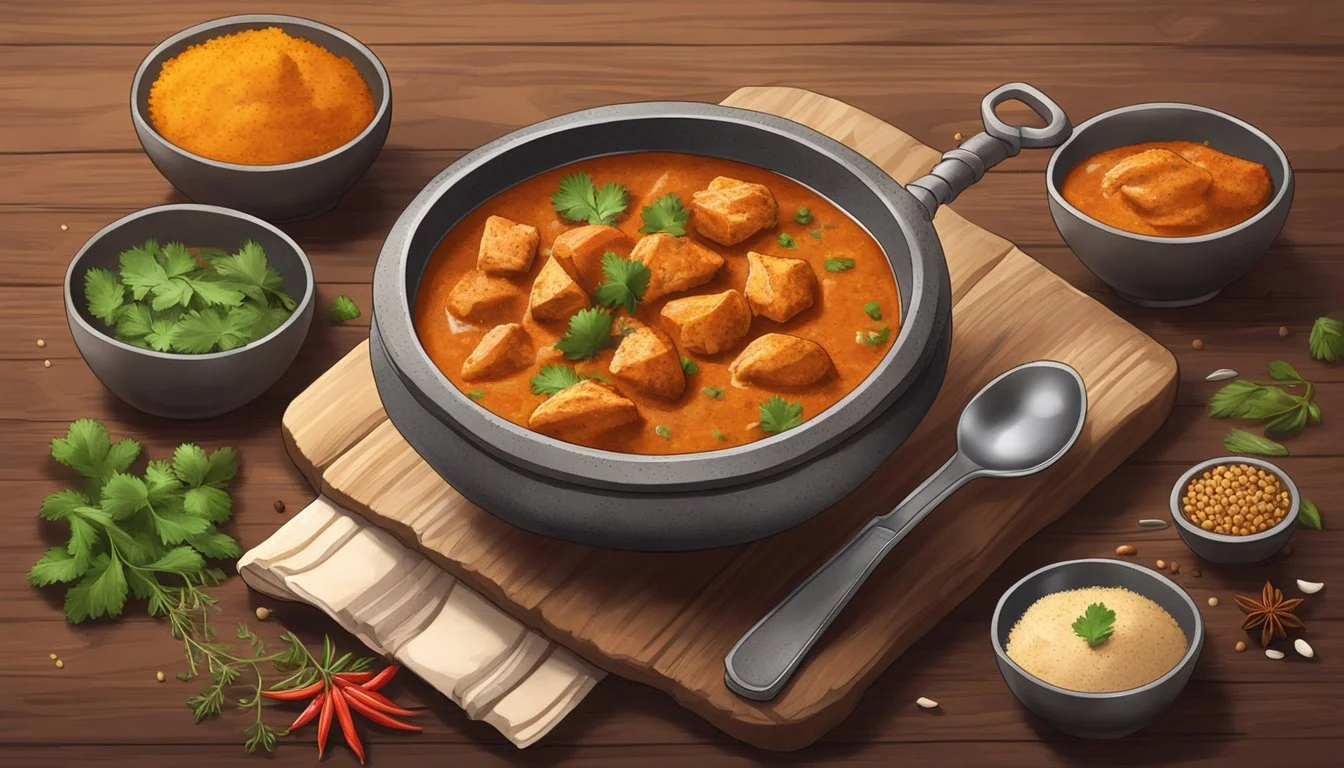How to Reheat Gluten-Free Chicken Tikka Malasa
Expert Tips for Best Results
Reheating gluten-free Chicken Tikka Masala should not compromise its rich, flavorful profile and healthy appeal. For those who love Indian food and follow a gluten-free diet, it's important to preserve both the taste and the nutritional integrity of this dish. Using the right reheating method is crucial for maintaining the creamy texture and spicy depth of the Chicken Tikka Masala.
Microwaving can be a quick option, but greater care must be taken to avoid drying out the chicken. Placing the masala in a microwave-safe dish, covering it, and heating at high power for short intervals with stirring in between helps in evenly reheating the meal. Oven heating at 350 degrees Fahrenheit for about 20 minutes can also ensure the dish is properly heated through without losing its signature flavors.
The stovetop method is another effective way to reheat this gluten-free meal. It allows for controlled, even heating while stirring ensures the sauce maintains its creamy consistency. This method typically takes around 5-10 minutes and is ideal for those aiming to enjoy their Chicken Tikka Masala as flavorful and tasty as it was originally prepared.
Understanding Gluten-Free Chicken Tikka Masala
Gluten-free chicken tikka masala retains the same vibrant flavors found in the traditional version but excludes any gluten-containing ingredients.
Ingredients commonly used include chicken breast, yogurt, tomato sauce, and cream.
The chicken is often marinated in a blend of spices and yogurt. This marinade usually includes paprika, turmeric, cumin, coriander, and garam masala.
Tomato sauce and cream are added to the dish, creating a rich and savory texture without gluten.
When preparing a gluten-free version, it's essential to ensure that none of the ingredients or seasonings contain hidden gluten.
Cross-contamination can be avoided by using dedicated utensils and cooking surfaces. Store-bought mixes or pre-made sauces should be checked for gluten content.
Reheating gluten-free chicken tikka masala can be done gently on the stovetop or in the microwave, preserving both its flavor and texture. By following these guidelines, you can enjoy this classic dish without compromising on your dietary restrictions.
Ingredients Breakdown
This section takes a closer look at the key components used in gluten-free Chicken Tikka Masala. Understanding the importance of each ingredient will help in preparing and reheating this delicious dish effectively.
Spices and Seasonings
Spices and seasonings are crucial for the rich flavors in Chicken Tikka Masala. Key spices include garam masala, cumin, coriander, paprika, turmeric, and fenugreek.
Garam masala provides a warm, aromatic base, while cumin and coriander add earthy tones. Paprika lends a mild sweetness and vibrant color. Turmeric is essential for its distinct yellow hue and subtle bitterness. Fenugreek seeds or leaves add a slightly nutty, sweet note. These spices are often best if freshly ground to maximize flavor.
Ginger and garlic are critical for depth and aromatic zest. They infuse the dish with a robust, pungent flavor that complements the spices.
Chicken and Marinade
Chicken breasts are typically used for their lean texture. For a tender and flavorful result, the chicken is marinated in a mixture of yogurt, lemon juice, and spices. The yogurt tenderizes the meat, while the lemon juice adds brightness and helps break down proteins.
The marinade usually includes garam masala, cumin, coriander, paprika, ginger, and garlic, enhancing the chicken's flavor profile. Marinating for at least a couple of hours or overnight yields the best results. This also ensures the spices penetrate deeply, making the chicken extremely flavorful.
Gluten-Free Alternatives
Making Chicken Tikka Masala gluten-free requires careful selection of ingredients. Gluten-free spices and yogurt are essential. Check that spice mixes, like garam masala, do not contain gluten-based fillers.
Using coconut milk instead of traditional cream or butter helps keep the dish dairy-free and gluten-free. Be cautious about store-bought sauces, as some may contain gluten. Reading labels and choosing certified gluten-free products ensures the dish is both safe and delicious for those with gluten sensitivities.
Sauce Base
The sauce is the heart of Chicken Tikka Masala, typically made with tomatoes, onions, garlic, ginger, and a blend of spices.
Tomatoes provide a tangy, sweet base, often utilizing both fresh and canned tomatoes. Onions add sweetness and depth, usually sautéed until golden brown. Garlic and ginger round out the aromatic base, adding warmth and pungency.
To thicken the sauce, coconut milk can be used, offering a creamy texture without the need for dairy. This not only keeps the dish gluten-free but also rich and luxurious.
Cilantro is often added at the end for a fresh, vibrant finish, enhancing the dish's presentation and flavor.
Preparation Before Reheating
Proper preparation of gluten-free Chicken Tikka Masala leftovers ensures delicious and safe consumption. Emphasis should be placed on appropriate storage and thawing to maintain the dish’s flavor and texture.
Storage Tips
Store leftover gluten-free Chicken Tikka Masala in an airtight container to prevent contamination and preserve freshness. Refrigerate within two hours of cooking to avoid bacterial growth.
For longer storage, place the container in the freezer, ensuring it's labeled with the date. Use within three months for best quality. Additionally, wrapping the container in aluminum foil provides extra protection against freezer burn.
It’s advisable to store the leftovers in portion sizes to match future reheating needs. This cuts down on repeated reheating, which can degrade the meal’s quality.
Thawing Process
Thawing chicken tikka masala properly is crucial. To thaw in the refrigerator, move the frozen container to the fridge and allow it to thaw slowly overnight. This method maintains food safety and preserves the dish’s texture.
If a quicker thawing process is needed, use the microwave’s defrost setting. Place the container in the microwave, adjusting the settings to a low power mode. Periodically check and stir the dish for even thawing.
Avoid thawing at room temperature, which can lead to uneven thawing and potential bacterial growth. Quick and safe methods ensure the gluten-free Chicken Tikka Masala is ready to be reheated without compromising quality or safety.
Reheating Methods
There are several effective ways to reheat gluten-free chicken tikka masala. Each method has its own benefits, whether you prefer the convenience of a microwave, the control of stovetop cooking, or the even heat of an oven.
Microwave Technique
Using a microwave is the fastest way to reheat chicken tikka masala. Place the leftovers in a microwave-safe container and cover with a microwave-safe lid or plastic wrap.
Steps:
Set the microwave to high power.
Heat for 1-2 minutes.
Stir the dish midway.
Continue heating for another 1-2 minutes if needed until it reaches an internal temperature of 70°C (158°F).
To avoid overheating, check the dish frequently to ensure it doesn't dry out.
Stovetop Approach
The stovetop offers better control over the reheating process. This method preserves the texture and flavor of your gluten-free chicken tikka masala.
Steps:
Preheat a non-stick pan on low-medium heat.
Place the chicken tikka masala in the pan.
Stir occasionally to prevent sticking.
Heat gently for about 5-7 minutes or until thoroughly warm.
Covering the pan with a lid can help retain moisture and flavors.
Oven Reheating
Using an oven provides consistent and even heating, making this method ideal for larger portions.
Steps:
Preheat the oven to 350°F (175°C).
Place the chicken tikka masala in an oven-safe dish.
Cover with aluminum foil to prevent drying.
Heat for 10-15 minutes or until it reaches the desired temperature, making sure to check occasionally.
This method is excellent for evenly heating the dish without sacrificing quality.
Alternative Methods
Other methods such as using a slow cooker or an air fryer can also effectively reheat chicken tikka masala.
Slow Cooker:
Place the dish in the slow cooker.
Set to low heat.
Heat for 2-3 hours.
Stir occasionally.
Air Fryer:
Preheat to 350°F (175°C).
Place the chicken tikka masala in the air fryer basket.
Heat for 5-7 minutes.
Shake the basket midway through the process for even heating.
These methods might take longer but can offer unique benefits like retaining moisture and adding a crispy texture where applicable.
Post-Reheating Tips
After reheating gluten-free Chicken Tikka Masala, there are several important steps to ensure the meal is safe, tasty, and nutritious. These steps focus on checking the temperature, maintaining moisture, and serving suggestions suitable for this protein-rich dish.
Checking Temperature
Ensuring the reheated Chicken Tikka Masala reaches the appropriate temperature is crucial for food safety. Use a food thermometer to check that the internal temperature reaches at least 165°F (74°C).
This temperature ensures that any potential bacteria are killed, making the leftovers safe to consume. If the dish has not reached this temperature after reheating, continue heating in 1-minute increments and recheck the temperature until it reaches the safe zone.
Maintaining Moisture
Retaining the creamy texture and moisture of Chicken Tikka Masala is essential for a pleasant eating experience. After reheating, you may notice some drying out. To combat this, consider stirring in a small amount of coconut milk, yogurt, or cream.
These ingredients not only rehydrate the dish but also enhance its richness. If reheating on the stovetop, covering the pan with a lid helps trap steam, maintaining the dish's moisture. If dryness persists, adding a splash of water or chicken broth can make a big difference without altering the flavor significantly.
Serving Suggestions
Pair the reheated Chicken Tikka Masala with suitable gluten-free accompaniments to create a complete meal. Gluten-free naan, rice, or quinoa are excellent options that complement the dish's flavors.
For a balanced plate, add a side of steamed vegetables or a fresh salad, which can enhance both the nutrition and taste of the meal. Additionally, sprinkling fresh coriander or adding a squeeze of lime can brighten the flavors.
Properly portioning and organizing the plate ensures each serving is visually appealing and satisfying. These suggestions help maintain the meal's quality while ensuring that it remains a delicious and nutritious part of your diet.
Accompaniments and Variations
When enjoying gluten-free Chicken Tikka Masala, consider several side dishes and dietary adjustments to complement and accommodate different dietary preferences.
Side Dishes
Consider pairing gluten-free Chicken Tikka Masala with basmati rice or cauliflower rice for a low-carb option. Garlic naan can be a delightful addition, provided it's made gluten-free. Steamed vegetables like broccoli, carrots, or peas can add texture and nutrition.
Freshly chopped cilantro adds a herbaceous note. Serving with a wedge of lemon provides a zesty kick. Additionally, a side of cucumber raita can help balance the spices. For a richer meal, consider accompanying the dish with a light lentil soup or dal.
Dietary Adjustments
For vegetarians, replace the chicken with firm tofu or paneer. Chickpeas or cauliflower can serve as hearty alternatives. To make the dish vegan, use dairy-free yogurt and substitute the paneer with tofu or a similar plant-based protein.
When meal prepping, store portions with rice or vegetables for balanced servings. Keeping cooked rice and naan separate when freezing helps maintain their texture upon reheating. Labeling containers with dates helps manage freshness. Lastly, select low-sodium versions of ingredients for a heart-healthy modification.
Final Thoughts
Reheating gluten-free chicken tikka masala ensures that the flavors and textures remain enjoyable. Using methods like the microwave, oven, and stovetop helps achieve the best results.
Microwaving is quick and convenient. Covering the dish and stirring halfway prevents drying.
For larger portions, the oven method works well. Preheat the oven to 350°F (175°C) and bake for 15-20 minutes, covered with foil.
The stovetop method is also effective, especially for those preferring a gentler reheating process. Heat on low-medium for about 5-7 minutes per side.
Reheating methods vary in effectiveness, but a general rule is to avoid overheating to maintain moisture and flavor. Always ensure the dish reaches an internal temperature of 165°F (74°C) for safety.
This dish, whether made homemade or from an Indian restaurant, remains a flavorful meal even when reheated. Keep in mind that while it can be a tasty bite, it’s important to consider nutrition and calories.
Adopting proper reheating techniques can maximize the pleasure of enjoying gluten-free chicken tikka masala multiple times without compromising on its quality.






